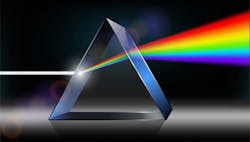Learning Optics with Austin: Lesson 9 – Light Waves
In “What is Light?”, we described light as both a wave and a particle under the conditions of the wave-particle duality. In the previous posts, we have mostly modeled light as a ray when discussing reflection and refraction. Only when we talk about diffraction and wavelength do we mention the wave property of light. While the wave property of light involves more technical knowledge, it answers the question of why white light emerges from a prism as a rainbow.
Transverse Wave Diagram
To start, light travels as a transverse wave, meaning that its direction of vibration is perpendicular to the direction of propagation. While we indicate the direction of propagation with an arrow, light is in fact oscillating perpendicular to the direction of propagation. In discussing the oscillation aspect, we go back to concepts of frequency, wavelength, and the index of refraction (n) mentioned in “How to Describe Light” and “How Does Light Travel?”.
Drill Bit
A good analogy of the relationship between these three variables is a drill bit. Let the spiraling motion of the drill bit remain constant which is analogous to the frequency of light. The speed at which the bit advances through a particular substance is analogous to the speed at which light travels. So if the bit starts spiraling in air and makes contact with wood, it encounters resistance and moves forward at a slower speed, even as its spiraling speed remains constant. This is analogous to light entering glass where the speed of light slows down but the frequency remains the same.
Frequency Equation
For 2 different frequencies of light, their speed in a vacuum is the same, just as if we had 2 drill bits with different spiraling speeds, but traveling forward at the same speed. To travel forward at the same speed, the slower bit would have to travel more distance forward in one turn. Therefore, the faster the speed of the drill, the greater the resistance, and the greater the forward speed change. For light, the higher the frequency of light, the greater the influence of the medium and the slower the forward speed in the medium.
Prism and Rainbow
The different forward speeds of light when traveling through a medium explains why white light breaks into a rainbow after traveling through a prism. Since the colors of light have different wavelengths (and thus frequencies), this causes colors with lower frequencies (red) to travel faster than colors with higher frequencies (violet). A white beam of light thus breaks apart into the different colors- a more detailed explanation than white light refracts when traveling through a prism.

Austin from Shanghai Optics Inc
Hello! My name is Austin and I am the host for this blog. I graduated from Rutgers in May 2021 with a Bachelor’s degree in Statistics-Mathematics and History. I interned during the summer of 2021 at Shanghai Optics working on data cleaning and analysis. I was later offered to work full-time starting in September. While my initial role was in data analytics, I realized that my knowledge of the company’s products was quite shallow as a key skill for any well-trained data analyst is to know your data. That’s how I got started on my journey in learning about optics.
I found physics interesting but challenging in high school. I did not particularly enjoy classical physics and a seminar in quantum mechanics flew over my head in college. As I see first-hand how our optics works in different applications, I’m quickly beginning to realize that Photonics has the potential to shape the present and the future. Because of my newfound enthusiasm, management took notice and I am fortunate enough to begin a Physics/Photonics class sponsored by Shanghai Optics in the fall of 2021. This blog is part of my experience in taking the class and sharing with you all the wealth of knowledge I’m acquiring!
Aside from optics, some of my personal interests include studying history and going on hikes. Both activities are great opportunities to talk with other people so feel free to ask me any questions on my personal interests or the materials I post!

